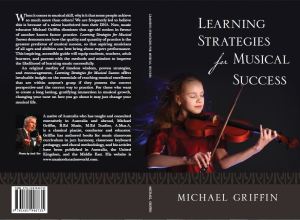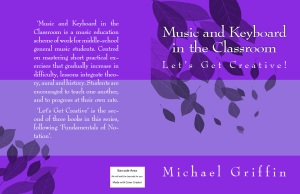Continued from Musical Creativity: Part 1
Students who learn in creative ways learn well. Creative learning is fun, engaging, and motivating. It requires identifying problems, considering multiple possibilities, making decisions, and finding solutions. Creative people are more likely to have adopted a growth-intelligence-mindset. They are prepared to take risks and are prepared to fail. They understand the value and necessity of making mistakes. Creative people are open to new experiences. They allow their imaginations to be inspired by anything and everything, including the sounds around them, nature, art, and music. They have heroes and role models, and delight in examples of excellence. While an individual cannot be creative without acting intelligently, creative people are not necessarily the smartest in their domain. In the confines of the old IQ system there is a correlation linking creativity with intelligence only up to the threshold score of approximately 120. This implies that creative people need to be fairly intelligent but not excessively so.
At the pinnacle of musical creativity is the ability to compose and improvise. Jazz improvisation requires serious engagement underpinned by a consummate level of musicianship. Simultaneously the improviser’s short-term memory must attend to harmony, melodies and patterns, form, musical expression, and rhythm to produce meaningful and contextual melodies on the fly. (Not surprisingly, creativity experts have a found a correlation between creative people and the capacity of their short-term memories.) For pianists the challenge is even greater as they are also required to accompany themselves with the left hand while the right hand improvises. This requires voicing rootless chords with a bass player and constructing a bass line when playing as a soloist. An essential requirement for improvisation is the ability to take risks and a preparedness to make mistakes. In improvisation, a mistake is not a mistake until the next note puts the former note into context. As Dave Brubeck said “There is no such thing as a wrong note – so long as it can be resolved”. Thus, if a musician plays a wrong note or makes a poor note choice, they can correct it with the next note. Such ‘wrong’ notes can even provide new impetus and inspiration for the rest of the improvisation. In this way mistakes ultimately can become catalysts for creativity.
The abilities to play by ear and from memory increase the potential to improvise. Competent improvising, however, requires both structure and freedom. Without structure, there is chaos; with too much structure there’s no creativity. Gaining proficiency with jazz structures involves a great deal of rote learning. Melodic patterns, chord progressions, chord voicing, and harmonies must be rendered to a level of automation to free up short-term memory for stylistic considerations. To master this ability, jazz improvisers practise their repertoires and associated patterns in several keys, and sometimes in all twelve. As improvisers become fully engaged with their craft they become totally absorbed and find flow. ‘Freedom’ also refers to freedom from self-consciousness and inhibition. Scientists have found that a region of the brain linked to inhibition is less active in jazz musicians than in other musicians who do not improvise.
An except from ‘Learning Strategies for Musical Success’ by Michael Griffin
“A must read for all music educators” – Robert Adams, Music Educator, New Haven, USA.
“A must buy for every music teacher and music student” – William Bruce, Guildhall School of Music, UK.
“A deeply impressive work, the breadth of research is fascinating!” Robert Chamberlain, Team of Pianists and Monash University Piano Staff, Victoria Australia.
“I have read your book and it has made an amazing difference in my teaching and in my studio.” Beth Cruickshank, Past President – Ontario Registered Music Teachers Association.
Amazon
Amazon UK
Kindle US
Kindle UK
Foyles UK
Australia: Contact mdgriffin63@gmail.com for direct mail.
Also by Michael Griffin
Music and Keyboard in the Classroom: Fundamentals of Notation is a unit of work for general music middle school classes. Designed around the mastering of practical skills, it integrates theory, aural and history, and allows students to progress at their own rate. View Table of Contents. “This has been a great buy, the books are just superb! Interesting topics with a wide range of pieces. Great content with clear progression of learning. Fascinating teaching philosophy! BRAVO!” -The Grieg Academy, London. Available at Amazon.com
Music and Keyboard in the Classroom: Let’s Get Creative! is the fun and creative extension to ‘Fundamentals of Notation’.
View Table of Contents. “We have been using your keyboard course and the results have been amazing!” – St George College, Australia
Available at Amazon.com
‘Bumblebee: Rounds & Warm-ups for Choirs’
Bumblebee! is more than just a collection of 84 choir exercises and rounds. The author shares timeless wisdom to help you get your choir – primary or secondary – into shape.
View Table of Contents.
“This is really good for all kinds of vocal groups, choirs, conductors. Bravo!!”
“The thinking person’s guide to training a choir. Love it!”
“It’s great to have some fresh warm-ups to add to the repertory. The tips for actions and techniques are really useful, and the advice at the back of the book has made me review some of my strategies.”
Modern Harmony Method: Fundamentals of Jazz and Popular Harmony (Third Edition, 2013) is a clear and well organised text suitable for students of arranging and composition, and for classically trained musicians wishing to grasp the beautiful logic of jazz harmony. Essential understandings include chord selection, voicing, symbols, circle of 4th progressions, extensions, suspensions and alterations. Included in the 107 pages are explanations, examples, exercises and solutions. The course can be started with students in year 9 and worked through to year 12 musicianship, composing and arranging. Available at Amazon.com





[…] Musical Creativity (& improvisation) : Pt 2 of 2 […]
Hi Jeff
I’m not sure what your comment is?
Regards
Michael